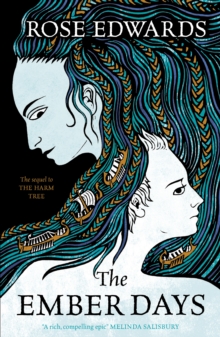I have a guest post for you guys! And I feel like this might fit lovely with me trying to read more spooky reads this month!
Rose Edwards is the author of The Harm Tree and its upcoming sequel Ember Days. Now, not going to say much about Ember Days (spoilers) but let's see how far I can tell you about Harm Tree. The land of Arngard is recovering from the last civil war, and is dangerous close to another. Torny and Ebba are two friends who are sent away, not remembering the war. But when Torny sees a man murdered in the street and she finds herself in possession of a dangerous message, the two find themselves on separate paths...
And all the while, the Harm Tree stands...
I am thrilled that the author of Harm Tree and Ember Days, Rose Edwards, has agreed to write a small guest post about plotting. I think you guys might like to read it!
Now, before I hand you over to Rose, I want to thank her for finding the time to write this post and, if you want to say hi to her, you can by popping her a tweet at @redwardswrites. Also, quick thank you to Graeme from UClan Publishing for chatting to me about this. Also, if you're curious about The Harm Tree, you can check out UClan Publishing's website.
Now, TO ROSE!
Plot is one of the things I find hardest. I think this is because to me, outlining a plot is a bit like creating Frankenstein’s monster out of dead bodies. Yes, it has limbs, a body, a head - but until the lightening strikes, who knows if it will stand by itself?
For me, plot grows from characters. Inner experiences and beliefs influence the outer world. Before I know the ending, I have to know the characters.
I’m not saying this is right and proper. It’s frequently annoying and worrying, not least for agents, publishers, and people at parties, who are always saying, “But you know how it’s going to end, right?”
Yes, I tell them.
That is a lie. But people really hate the answer “No,” even if they have only just met you and are not entirely sure why they’re making small talk with you.
Writing The Harm Tree, I had a structure - Torny and Ebba’s alternating voices, their stories sepearate but reflecting one another - and I had the arc of development, which in YA is usually also the arc of growing up. That, and a vague sense of the final conflict, was where I started from. The plot was just events hanging together until I found the spark.
For The Harm Tree, that spark was the understanding that the story was about trauma. It was about how you can seem strong until you’re hit by it, and how you can seem weak until you find a way to move through it. And once you have that spark, well, then you’re not just standing, you’re running. I saw exactly how it all hung together, how the meaning shaped every event.
I found the spark relatively late in the process, and not all at once. It came to me through moments of revelation: while running, while falling asleep, those times when the brain is more body than thought.
You may imagine how agents and publishers and people at parties view such a work process, and I sympathise. It sounds, at best, unreliable.
Of course, to reach those moments, I had to write. I’m not talking about sudden inspiration. If I had waited around for inspiration, the book would never have been written. I’m talking about the way you work away at a problem day by day, finding the right pieces, sewing them together, until there is a vessel ready for the lightening to fill.
Some people can presumably perform this trick from the beginning. I should very much like to know how.
When I first wrote The Harm Tree, I wanted it to be a stand-alone. I wanted readers to feel that the story had cycled through a complete turn of the wheel. And then, once it was picked up for publication, I was offered the chance to turn the wheel again.
When I first wrote The Harm Tree, I wanted it to be a stand-alone. I wanted readers to feel that the story had cycled through a complete turn of the wheel. And then, once it was picked up for publication, I was offered the chance to turn the wheel again.
The question at the heart of The Harm Tree was “How do you live through something terrible and survive?” No promises were made about the future.
What I wanted to say in The Ember Days was: “Survival is not enough. You deserve more.”
I took the structure of the first book and decided there were good reasons a second book would work. The two voices would again echo and reflect one another, but now the two books would as well. Instead of running home, Ebba and Torny would be running away. Instead of apart, they would be together. The first book looked inward; the second would look outward, far beyond the borders of the world the friends had known. The two pieces would be part of the whole, the world on either side of the mirror.
Plotting doesn’t come easily to me. Grand designs do. I knew the beats, I knew my characters, and most importantly, I had an answer. It may not be right or proper. It’s certainly not the only one. But it’s the one that has given me more than just survival.
All I can do is keep writing. And then, when the lightning strikes, be ready to run.


No comments:
Post a Comment